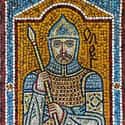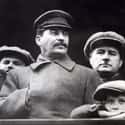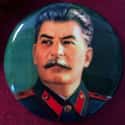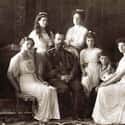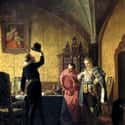-
(#2) 882 - 1240: Kievan Rus Dynasty
Key Leaders: Oleg, Igor, Olga, Svyatoslav, Vladimir I
Known for: Capture of Kiev, establishment of the first Kievan Rus law code, introduction of Christianity, early battles with the Mongols
Oleg and his successors - Igor (allegedly the son of Rurik), Igor's wife Olga, and their son Svyatoslav - consolidated control of the area around Kiev during the 10th century. During the reign of Igor's grandson, Vladimir, Christianity was introduced and the Rus control over Kiev was solidified. The lands were organized into a confederation of states based in nearby cities and led by Vladimir's sons.
Vladimir created a hierarchy of sorts and a patterns of succession involving younger brothers and nephews replacing deceased leaders throughout the various territories. The eldest son was the Grand Prince (sometimes called the Grand Duke) of Kiev. Through the eleventh, twelfth, and part of the thirteenth centuries, Kiev carried out military battles and engaged in trade activities, extending their sphere of influence south to the Baltic Sea. However, there were tensions involving the order of succession. Princes sometimes attempted to seize power instead of waiting their turn and territories occasionally rejected their given leader.
During the thirteenth century, the Princes came into increasing contact with the Mongols. At the Battle of Kalka River in 1223, the Mongols made their first attempt to invade Russia and destroyed the Kievan army.
-
(#16) 1936 - 1953: The Great Terror And Rise Of The Soviet Union As A Super Power
Notable leaders: Josef Stalin
Known for: Death of millions of Russian citizens, Russia's involvement in World War II, expansion of the Soviet Empire
From 1936-1939, Stalin carried out his "Great Terror" by staging trials for Communist Party and Red Army members as well as anyone else that he feared were conspiring against him. Stalin killed, exiled, and imprisoned millions of Russians during the Great Terror.
Communist Russia signed a non-aggression pact with Hitler and Nazi Germany in 1939. When the Nazis violated that and invaded in 1941, Russia joined the Allies in World War III. Soon after the war, Russia and the United States emerged as the world's superpowers, ushering in the Cold War.
The Soviet Union's sphere of influence extended throughout Eastern Europe with governments that were dependent upon Moscow formed in Poland, Czechoslovakia, Hungary, Romania, and Bulgaria in 1948. The soviets, or local or regional governmental bodies under the control of Moscow, made up the growing Union of Soviet Socialist Republics, the USSR.
-
(#15) 1924 - 1953: Rise Of Stalinist Russia And The USSR
Key Leader: Josef Stalin
Known For: Collectivization, the Great Terror
After Lenin died, Josef Stalin, the General Secretary of the Communist Party, and Leon Trotsky, the head of the Red Army, competed for control of Russia. Stalin won out by eliminating all of his rivals. He exiled and murdered his naysayers and competitors, completely seizing power and declaring himself dictator in 1929.
During the late 1920s and early 1930s, Stalin implemented his First Five Year Plan, which forced industrialization and collectivized agriculture - essentially undoing Lenin's NEP. Collective farming was unpopular among the peasantry and unsuccessful in meeting the needs of Russia, but industry grew and transformed Russia into an increased urban society. Heavy industry was emphasized over all other aspects of economy and life in Russia.
-
(#5) 1533 - 1581: Rise Of Ivan The Terrible And Establishment Of The Tsar System
Key Leaders: Ivan IV
Known For: Establishment of the tsar in 1547 and beginning of widespread government surveillance
After amassing a personal fortune and conquering several rivals, Ivan IV became the Grand Duke of Moscow in 1533. Known as Ivan the Terrible, he was prone to violent outbursts and used ruthless military tactics to push back the Mongols and reconquer ancient Russian lands. In 1547, he was crowned the "tsar of all Russia." As tsar, Ivan minimized the power of the noble class, took dictatorial power over the area surrounding Moscow, and punished traitors and law breakers severely.
The system of justice under Ivan IV, the Sudebnik, clearly defined laws and punishments while eliminating corruption and judicial misconduct. Ivan also created the Oprichniki, the first secret police in Russia. The Oprichniki rode through Russia on black horses with saddles emblazoned with a symbol of a broom and a dog's head. The broom signified Ivan's intention to sweet Russia of corruption and the dog's head was a reminder the czar was always watching.
-
(#13) 1905 - 1917: The Duma, Constitutional Reform, And The Introduction Of Communism
Key Leaders: Nicholas II
Known For: End of the tsarist government, establishment of Communist RussiaThe Russia Duma was in place from 1906 to 1917, but was ineffective in bringing reform to fruition. A series of dumas met over the next decade, many of them dissolved by the tsar due to their liberal agendas. In the end, the Duma established a new provisional government and Nicholas II abdicated the throne.
The provisional government attempted to establish universal suffrage, elections for all government officials, and equality for all, but lacked the authority and cohesiveness to get any legislation passed. It lasted for only eight months before Vladimir Lenin and the Bolsheviks seized power in October 1917.
-
(#6) 1581 - 1605: End Of Rurik Dynasty And Rise Of False Dmitri
Key Leaders: Feodor I, Boris Godunov, Feodor II, False Dmitri I
Known For: The end of the Rurik Dynasty and the beginning of the Time Of Troubles
Towards the end of his reign, Ivan IV became increasingly hostile and erratic. He married five wives through the 1570's, but only produced one son suited to serve as his successor. However, Ivan IV murdered that son in 1581. This set the course for a series of events known as the Time of Troubles, lasting roughly from 1598 to 1613.
Ivan's son Feodor, eventually became the new tsar, but was considered feeble-minded and ill-suited as a ruler. He was largely a figurehead during his reign and, upon his death at 40, Ivan IV's family had no remaining heirs to the throne. Boris Godunov, Feodor I's former guardian, became the new tsar. In the early 1600's, droughts and famines caused political turmoil throughout Russia. After Godunov's sudden death, things only got worse when his son, Feodor II, assumed the role of tsar.
In 1605, A man known as "False Dmitri" claimed to be Ivan IV's son and therefore the rightful heir to the throne. Ivan IV's son, Dmitri, had been stabbed to death under mysterious circumstances at the age of 9 and a half, but False Dmitri claimed he had actually escaped the attack and been on the run. Despite the dubious nature of his claims, False Dmitri gained a considerable following. He eventually stormed Moscow with an army, assassinating Gudunov's wife and Feodor II and assuming power as the new tsar.
New Random Displays Display All By Ranking
About This Tool
In Russia's thousand-year history, turmoil and crisis seem to be the norm in Russian society. Looking back at the time from the Kievan Rus era to Putin's administration, the Russian government system has undergone tremendous changes. From the early Mongolian invasion to the Tsarist regime to the Soviet system, to the revolution becoming a presidential republic. Russia's development history is full of turbulence and crisis, and it is constantly changing and improving.
Russia is not only famous for its strong national power and the rise of its political system, but also for its various artistic and cultural contributions, such as ballet, Tolstoy, Tchaikovsky, vodka, etc. The random tool introduced 13 government systems in Russian history.
Our data comes from Ranker, If you want to participate in the ranking of items displayed on this page, please click here.











